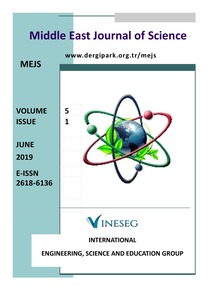A NEW APPROACH TO THE PRODUCTION OF LAMINATED COMPOSITES CONSISTING OF AL2O3 REINFORCED AND UNREINFORCED 7039 AL ALLOY SHEETS
A NEW APPROACH TO THE PRODUCTION OF LAMINATED COMPOSITES CONSISTING OF AL2O3 REINFORCED AND UNREINFORCED 7039 AL ALLOY SHEETS
7039 Al alloy, Vortex process, MMC Layer Composite,
___
- [1] Koizumi, M. (1997). FGM activities in Japan. Composites, B 28, 1-4.
- [2] Wang, S.S. (1983). Fracture mechanics for delamination problems in composite materials. J. Compos. Mater. 17 (3), 210-223.
- [3] Niino, M., Hirai, T.,& R. Watanable. (1987). The functionally gradient materials. J.Jpn.Soc. Compos. Mater. 13, 257-264.
- [4] Shanmugavel P., Bhaskar, G.B., Chandrasekaran, M., Mani, P.S., & S.P. Srinivasan. (2012). An overview of fracture analysis in functionally graded materials, Eur.J.Sci. Res. 68 (3), 412-439.
- [5] Jha, D.K., Kant, T., & Singh, R.K. (2013). Critical review of recent research on functionally graded plates, Compos. Struct. 96, 833-849.
- [6] North, B. (1987). Int. J. High Tech. Ceramics, 3, 113–127.
- [7] Adams, J. H., Anschuetz, B., & Whitfield, G. (1991). Ceramic Cutting Tools. In Engineered Materials Handbook, Vol. 4, Ceramics and Glasses, ASM International, Metals Park, OH, p. 966.
- [8] Montgomery, J.S., & Chin, E.S. (2004). The AMPTİAC Quarterly,8 (4), 16.
- [9] Perez-Bergquist, Sara J., Gray III, G.T. (Rusty)., Cerreta, Ellen K., Trujillo, Carl P., & Perez-Bergquist, Alex. (2011). The dynamic and quasi-static mechanical response of three aluminum armor alloys: 5059, 5083 and 7039. Materials Science and Engineering. A 528, 8733-8741.
- [10] Trotten, G.E., & MacKenzie, D.S. (2003). Al-Zn-Mg alloys, in: Handbook of Aluminum, Marcel DekkerInc., NY, 185-194.
- [11] Abdizadeh, H., Baharvandi, H.R., & Shirvani Moghaddam, K. (2008). Effect of B 4 C, TiB 2 and ZrSiO 4 ceramic particles on mechanical properties of aluminium matrix composites: Experimental investigation and predictive modelling. Mater. Sci. Eng. A 498, 53-58.
- [12] Onat, A., Akbulut, H., & Yılmaz, F. (2007). Journal of Alloys and Compound. 436 375-382.
- [13] Chen, R., & Zhang, G. (1993). Casting defects and properties of cast A356 aluminium alloy reinforced with SiC particles. Composites Science and Technology. Vol. 47, pp. 51-56.
- [14] Bolourı, A., Shahmırı, M., & Cheshmeh, E. N. H. (2010). Microstructural evolution during semisolid state strain induced melt activation process of aluminum 7075 alloy. Trans. Nonferrous Met. Soc. China 20, 1663−1671.
- ISSN: 2618-6136
- Yayın Aralığı: 2
- Başlangıç: 2015
- Yayıncı: -
EVALUATING OF UPHILL TIMBER SKIDDING WITH FORESTRY TRACTOR
Neşe GÜLCİ, Sercan GÜLCİ, Kıvanç YÜKSEL
DNA DAMAGE MECHANISMS OF ANTI-CANCER DRUGS
Bircan Çeken TOPTANCI, Göksel KIZIL, Murat KIZIL
Ömer ERDOĞAN, Giray TOPAL, Reşit ÇAKMAK, Murat SÜNKÜR, Mutlu CANPOLAT
CONTRIBUTIONS TO BINGOL FLORA AND BEEPKEEPING
HAZRO İLÇESİ (DİYARBAKIR) RHOPALOCERA FAUNASINA KATKILAR
Berna KAYMAK, Selime Ölmez BAYHAN
EFFECT OF FLOW AND SEDIMENT CONCENTRATION ON SOME WATER QUALITY PARAMETERS IN MURAT RIVER
